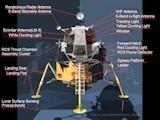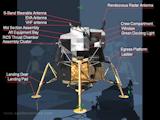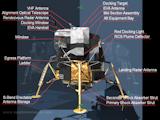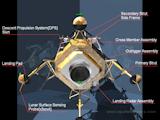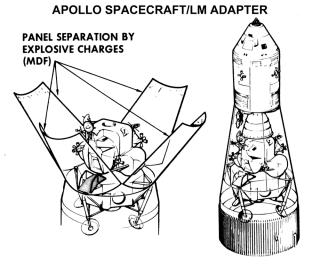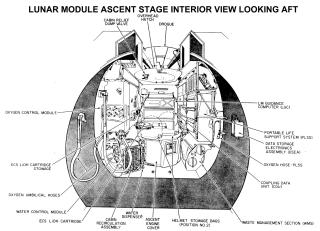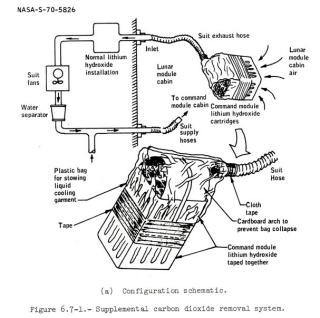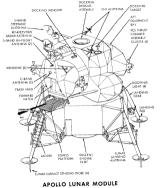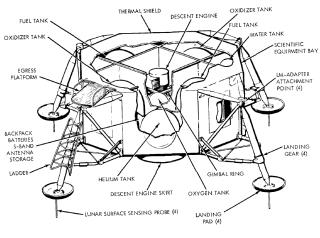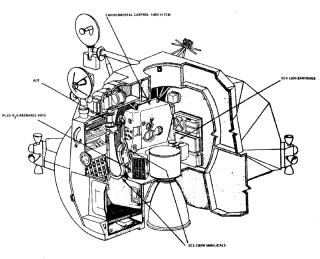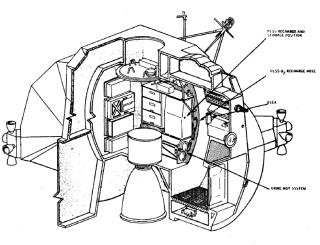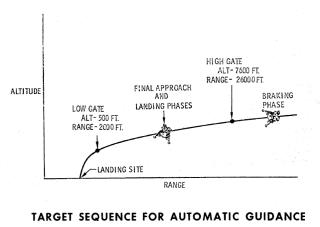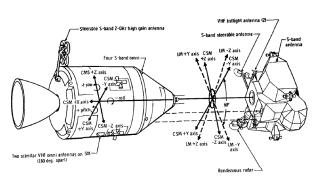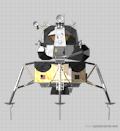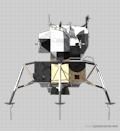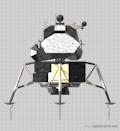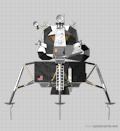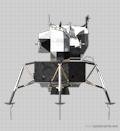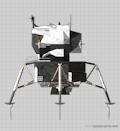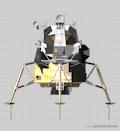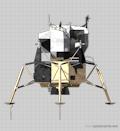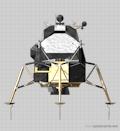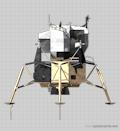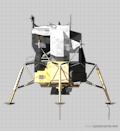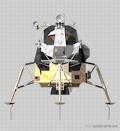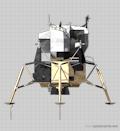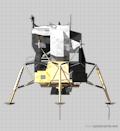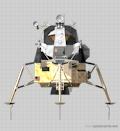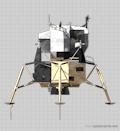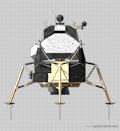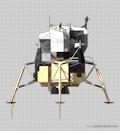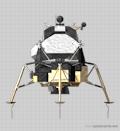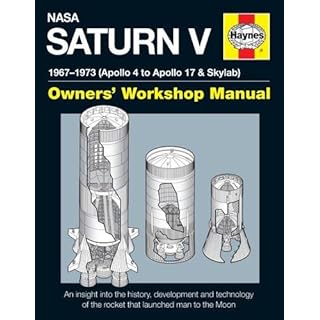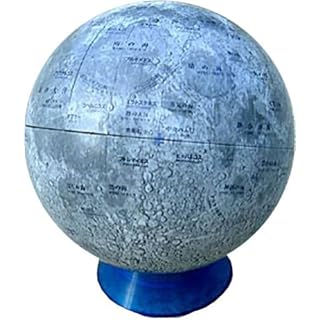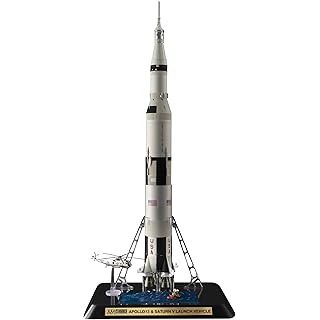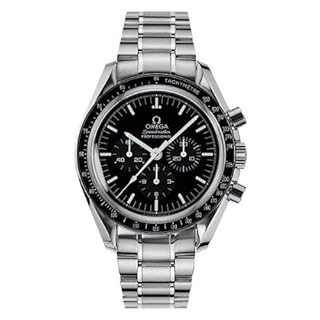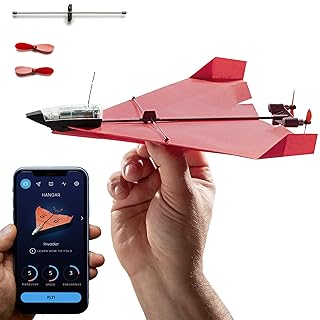Lunar Module(LM)
- Height : 23ft (7.0104m)
- Maximum Weight : 36244lb (16.454ton)
- Manufacturer : Grumman Aircraft Engineering Corp., Bethpage, N.Y.
Description


Ascent Stage

Because of the severe restriction of the weight, LM is being made thoroughly in the light weight. Most part of the body are only being put metal foil on the framework of aluminum.


Crew Compartment is 92 inches in diameter and 42 inches deep. There are two triangular windows and hatch to get off to the moon in front. Command pilot(CDP)'s console is on the left, Lunar Module Pilot(LMP)'s on the right inside, A little docking window is attached to the part of the roof on the CDP side. There is Equipment Storage of the left of CDP and the right of LMP. An environment control device, lithium hydroxide cartridge of the back pack (PLSS : PORTABLELIFESUPPORTSYSTEM), and so on are stored in the CDP side. A camera, food, and so on are stored in the LMP side. Velcro pile is bonded on the deck, and astronaut's shoes can be fixed under the zero gravity conditions. There is no chair in the cockpit because it is used only in the space and the surface of the moon. Astronauts binding a body with the cable and operations LM with standing. Front hatch is used for get off to the moon, It is a quadrangle in 32 inches square for going in and out with back-pack (PLSS). and opens to the inside on the LMP side. Hinge is being installed in the right, it opens to the inside on the LMP side. By the atmospheric pressure, it is sealed up with silicone sealing. You must operate the valve on the hatch and exhaust air inside the ship completely to open the hatch.


Two triangle windows and a docking window are form of 2 layers. Coating of 59 layer is made outside of the outer layer to shut out ultraviolet rays and so on. And, high efficiency reflection prevention coating is made in the inside and outside of the outer layer. Then, electric heater is provided for prevent dimness, but because it lacks a temperature watch function, astronauts must always check it. A covering board is being installed in all the windows. It is rolled up by side of the window when it isn't used.

There is an overhead hatch at the top of Mid Section to use for dock with CSM. This is diameter 33-inch circle, the structure is the same as front hatch, it opens inside.

The back area of Mid Section is "Aft Equipment Bay" that is not pressurized. Here is equipped with the electronic machine such as GN&CS, EPS, a communication system. These are cooled down with cold rails by Water-glycol flows. Two gaseous oxygen tanks and two gaseous helium tanks are being installed here.
Descent Stage


Descent Stage has the appearance of 8 corner shape. There are five square areas in the center and every direction. And there are four triangular areas in that neighborhood. DPS engine is carried in the central section. As for the square area of the circumference, oxidizer tanks are carried in the front and the back, fuel tanks are carried right and left. The trianglar area which between that, are called quad NO. 1,2,3,4, seen from the top, around the anti-clockwise.
by Thomas J. Kelly:
LM design chief

The whole of LM is wrapped in a thing like the seat of gold, silver or black. This is the seat which protects a body from intense heat and the micrometeorite. These are called as "Thermal Blanket" and are piled up to many layer of aluminum or inconel and nickel foil, and mylar and H-film blanket. How to spread this seat varies in any missons. Therefore the color of LM was decided delicately.
LM COLOR CHART
| LM-3 Apollo9 Spider |
|---|
| No Thermal Blanket on legs. Four Lunar Surface Sensing Probe are attached at all legs. Scimitar antenna on front face. No RCS Plume Deflectors. |
| LM-4 Apollo10 Snoopy |
|---|
| No Thermal Blanket on legs. Four Lunar Surface Sensing Probe are attached at all legs. Scimitar antenna on front face. No RCS Plume Deflectors. |
| LM-5 Apollo11 Eagle |
|---|
| Three Lunar Surface Sensing Probe are attached legs except front. RCS Plume Deflectors are added. |
| LM-6 Apollo12 Intrepid |
|---|
| Atomic power generator was added at Quad2. |
| LM-7 Apollo13 Aquarius |
|---|
| About the same specification with LM6. |
| LM-8 Apollo14 Antares |
|---|
| Made a drastic revision of Descent Stage color. |
| LM-10 Apollo15 Falcon |
|---|
| J mission version. Lunar Roving Vehicle on Quad1. |
| LM-11 Apollo16 Orion |
|---|
| About the same specification with LM10. |
| LM-12 Apollo17 Challenger |
|---|
| About the same specification with LM10. |
Related books and videos
-
Apollo Spacecraft - News Reference

Periscope Film LLC / ApogeeBooks 2005/11/26 USD60.00
The Ultra Rare and Coveted Apollo News Reference Manuals. These books have become legendary amongst the space collecting fraternity and have been known to sell at auction for as much as $6,000 for the pair. Now as a valued customer Apogee is proud to offer these beautiful replicas to add to your collection of Apogee Space Books. Each book comes with an accurate replica of the original 1960's cover and the pages are set out in the same sequence as the originals. Almost 500 pages of in depth detail about the Apollo spacecraft in the exact words of the contractors who built them.
-
Lunar Module LM 10 Thru LM 14 Vehicle Familiarization Manual

Periscope Film LLC 2013/01/01 USD18.05
Originally created for NASA in 1969 by prime contractor Grumman, this Lunar Module Vehicle Familiarization Manual was mandatory reading for Apollo astronauts, contractors and NASA support staff. This version of the manual describes the so-called ELM, or Extended Lunar Modules designed for the "J"class missions Apollo 15-17 and the never-flown Apollo 18 and 19. The ELM came about as part of NASA's efforts to enhance the scientific study of the Moon and its geology. To do that, longer surface stays would be needed. To make it possible, LM 10 to LM 14 received various modifications intended to increase their payloads, and allow them to return larger samples to Earth.
-
LEM Lunar Excursion Module Familiarization Manual

Periscope Film LLC 2011/03/09 USD15.40
Designed by Grumman's brilliant Tom Kelly, the Apollo Lunar Excursion Module (or "LEM" for short) was a triumph of purpose-built engineering. In the six years 1962-1968 between drawing board and first flight, a myriad of challenges were overcome related to weight, reliability and safety. The final design, designated the Lunar Module or "LM", boasted tiny windows instead of large portholes, four legs instead of five and most famously had no seats ― instead relying on the astronauts' legs to cushion a lunar landing.
-
Haynes Nasa Mission AS-506 Apollo 11 Owners' Workshop Manual: 1969 (Including Saturn V, CM-107, SM-107, LM-5)

Haynes Publishing 2009/12/01 USD32.95
On July 20, 1969, US astronaut Neil Armstrong became the first man to walk on the moon. The Apollo 11 mission that carried him and his two fellow astronauts on their epic journey marked the successful culmination of a quest that, ironically, had begun in Nazi Germany thirty years before. This is the story of the Apollo 11 mission and the ‘space hardware’ that made it all possible. Author Chris Riley looks at the evolution and design of the mighty Saturn V rocket, the Command and Service Modules, and the Lunar Module.
-
VIRTUAL LM: A Pictoral Essay Of The Engineering And Construction Of The Apollo Lunar Module

Scott P. Sullivan / Apogee Books Space Series 2004/07/31 JPY3,118
The Apollo Lunar Module is revealed in this book to be both an engineering masterpiece and a work of art.
-
Building Moonships : The Grumman Lunar Module

Joshua Stoff / Arcadia Publishing 2004/04/24 JPY2,461
In 1961, after the United States had acquired a total of fifteen minutes of spaceflight experience, President John F. Kennedy announced his plans for landing a man on the moon by 1970. The space race had begun. In 1962, after a strenuous competition, the National Aeronautics and Space Administration (NASA) announced that the Grumman Aircraft Engineering Corporation of Bethpage, Long Island, had won the contract to build the lunar module-the spacecraft that would take Americans to the moon. This was the first, and the only, vehicle designed to take humans from one world to another.
-
Moon Lander: How We Developed the Apollo Lunar Module

Thomas J. Kelly / Smithsonian Inst Pr 2001/03/01 JPY2872
Chief engineer Thomas J. Kelly gives a firsthand account of designing, building, testing, and flying the Apollo lunar module. It was, he writes, “an aerospace engineer’s dream job of the century.” Kelly’s account begins with the imaginative process of sketching solutions to a host of technical challenges with an emphasis on safety, reliability, and maintainability. He catalogs numerous test failures, including propulsion-system leaks, ascent-engine instability, stress corrosion of the aluminum alloy parts, and battery problems, as well as their fixes under the ever-present constraints of budget and schedule.




